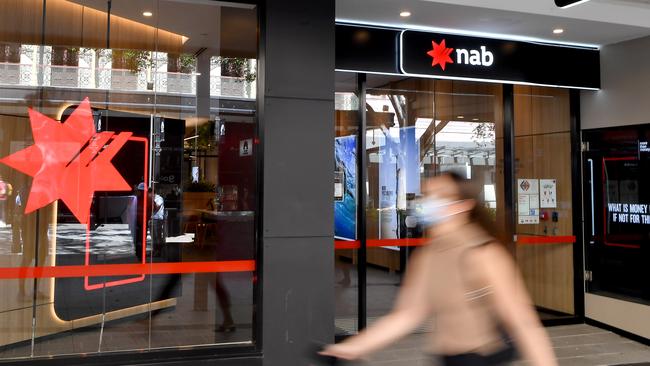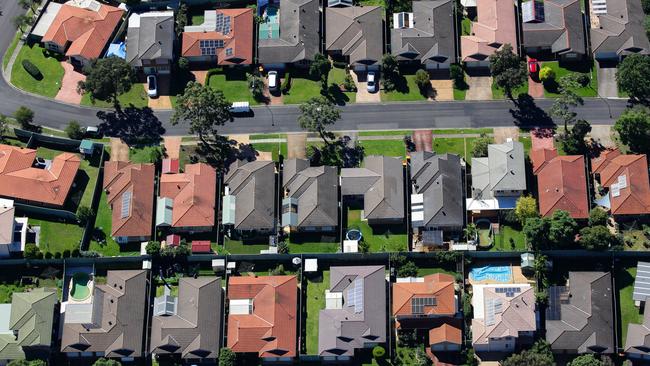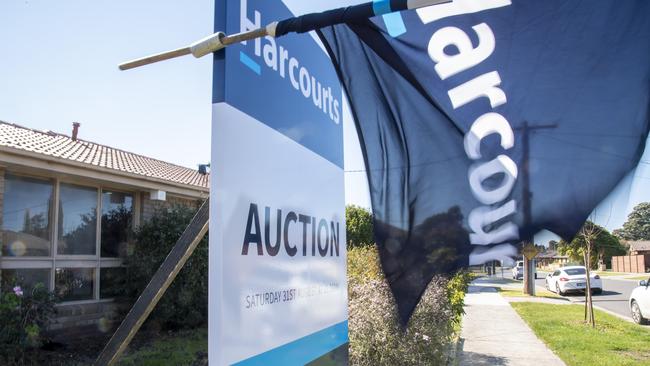
While house prices are clearly moderating – Sydney is off 3.4 per cent from its peak, Melbourne 3.1 per cent and lending volumes are down from the pandemic peak – the people whose businesses are built around property are calling resilience over gloom.
National Australia Bank says its volume of stressed loans, where payments are more than three months late – the most severe category – continued to push new lows in the period to the end of June.

This time last year, before interest rate hikes started biting, NAB’s ratio of the impaired loans to total lending book was 1.13 per cent.
Its latest update has this at just 0.7 per cent, including small to mid-sized business loans.
It’s a similar story at Suncorp, with its regional banking arm this week revealing 90 day past due housing loans had fallen to just 0.43 per cent of its total lending book. This time last year it was 0.85 per cent.
Commonwealth Bank, Australia’s biggest lender, on Wednesday released some of the money it it was holding in case of lending stress. CBA’s measure of stressed housing loans also fell in the year to end-June, while it said 34 per cent of its borrowers are more than two tears ahead on their loan.
NAB chief executive Ross McEwan says in the update the drop mainly reflects the “continued improvement” in mortgages.
Still, the rate hikes have seen lending volumes slow, with current Australian Bureau of Statistics figures showing the value of new housing loan commitments falling 4.4 per cent in June.
“As the economy changes, continued low unemployment and healthy household and business balance sheets are helping mitigate the impacts of higher inflation and higher interest rates,” McEwan says.
For some time he has been pointing out some 70 per cent of customer home loan repayments are ahead of schedule.
But McEwan has also sought to get ahead of the pain of further rate rises coming down the track, outlining a range of measures for mortgage customers including adjusting loan repayments, accessing redraw facilities or fixing loans.

Property tech player REA Group, whose core realestate.com.au business involves the listing of houses, says the market is clearly moderating.
REA chief executive Owen Wilson highlights that July figures show national residential listings up 7 per cent; they’re up 18 per cent in Sydney and 6 per cent in Melbourne.
He cites fundamental drivers of the market: record low unemployment, high household savings and the migration tap slowly being turned back on. Surging rental yields are also drawing investors back into the property market.
“As interest rates continue to rise, we do expect the market to continue to moderate. But if you look at it from today, if we lose another 5 per cent off property prices, we’re only back to August last year. Another 10 per cent and we are only back to May last year,” Wilson says.
“All that’s really happening here is the froth has been taken off the top of the market.”
Realestate.com.au searches give a forward indication of the temperature of buyer interest.
Here Wilson says REA had its highest audience in July, with some two million buyer inquiries sent to vendors, something he describes as “extraordinary”.
“There are still buyers there and I think that we are going to see that continue because of the strong economic fundamentals,” he says.

“With that environment and with increasing immigration, I think the demand for property is going to hold up. That’s going to give sellers confidence to try the market if they need to.”
Top ranked bank analyst Jon Mott of brokerage Barrenjoey set the tone when he last week pointed out $250bn of mortgages across Australia and New Zealand were written at close to maximum borrowing capacity in recent years. This underpinned his analysis that this could be the first bad debt cycle in 50 years led by households rather than business.
Bank executives say they are alert, not alarmed, and insist they are yet to see any stress, with households more likely to cut back aggressively in other areas than their loan.
They point to commercial property being the historic weak spot for Australian banks during slowdowns.
One bank executive has cited the famous “wagyu and shiraz case” of recent years, where the Federal Court was considering ASIC’s ultimately failed move in 2019 to take Westpac to court over alleged responsible lending breaches. There Justice Nye Perram argued that consumers’ past spending habits could not be used as a guide for their future spending habits, particularly when it came to taking out a mortgage. While the past few years have shown Australian housing to be able to withstand a number of shocks, even with lending restrictions in place in the period before the Covid-19 pandemic, REA’s Wilson says the market is not “bulletproof”. Jobs growth continues to be the No. 1 figure to watch.
“If unemployment was sitting at 7 per cent we’d be having a totally different conversation,” he says.
Counting the costs
Meanwhile, cost explosion is shaping up as the big challenge for Australian business, putting many executives in uncharted waters. With inflation taking hold through the economy, businesses are attempting to work out whether cost growth represents a short-term hit or is something more entrenched.
The first signs of accelerating costs have started to bubble through as NAB warned in its third-quarter update that expenses would be up 3 to 4 per cent for the year. In May it had forecast 0-2 per cent. In the first-quarter update in February, NAB was calling out a “broadly flat” expense line. You get the picture.
The bank, which saw its shares fall 2.9 per cent, pointed to a one-off top-up to provisions for payroll and customer remediation of $60m-$100m. But in an environment where annual inflation is running at more than 6 per cent and forecast to move higher, this starts to bite for companies that carry big fixed cost bases – including big banks.

One of those is CBA, with chief executive Matt Comyn on Wednesday saying annual staffing costs rose 9 per cent.
Others including Bowen Basin coal miner Coronado Minerals also saw a 30 per cent run-up in Australian mining costs over the year. NBN Co bucked the trend with its expense line falling 9 per cent, although this was largely due a large reduction in staffing costs following the completion of the initial build of the high-speed network.
REA is also feeling the cost squeeze, although its annual revenue growth of 18 per cent continues to run well ahead of last year’s 11 per cent expense growth.
The housing tech player now expects operating cost growth to come in at the “mid-to-high single digits” in the coming year. Some of the cost growth is linked to higher headcount on expansion moves, but can also be attributed to higher salaries in what it describes as a “tight labour market”.
REA is 61.6 per cent owned by News Corp, which is the publisher of this masthead.

REA’s Wilson says competition for skilled labour is not new. He has been facing a war for talent in the technology space for at least the past three years.
REA has just pushed though an annual wage rise for staff which Wilson says is “less than 5 per cent”, noting that is below the annualised inflation figure during the March quarter.
At the same time, with the aggressive sell-off in technology stocks over the past six months, Wilson says there is a slight shift, with REA starting to see some people become available.
Tech workers are increasingly attracted to a strong brands, with a “flight to quality” under way as some emerging companies experience cash pressures.
“As other tech companies are finding, an uncertain environment can work to our advantage,” Wilson says.
REA on Tuesday posted a 19 per cent lift in net profit to $385m for the year to end-June. The result was struck on a 26 per cent increase in revenue, which was partly helped by last year’s acquisition of listed mortgage broker Mortgage Choice.
REA shares jumped 6.6 per cent on Tuesday to $132.32, valuing News Corp’s stake in the company at $10.8bn.
johnstone@theaustralian.com.au




It’s clear housing market is being closely watched for the first signs of real stress as interest rates are hiked at the fastest pace in three decades. And there’s more rate pain to come over the rest of the year, with the central bank saying it is determined to put inflation back in its box.